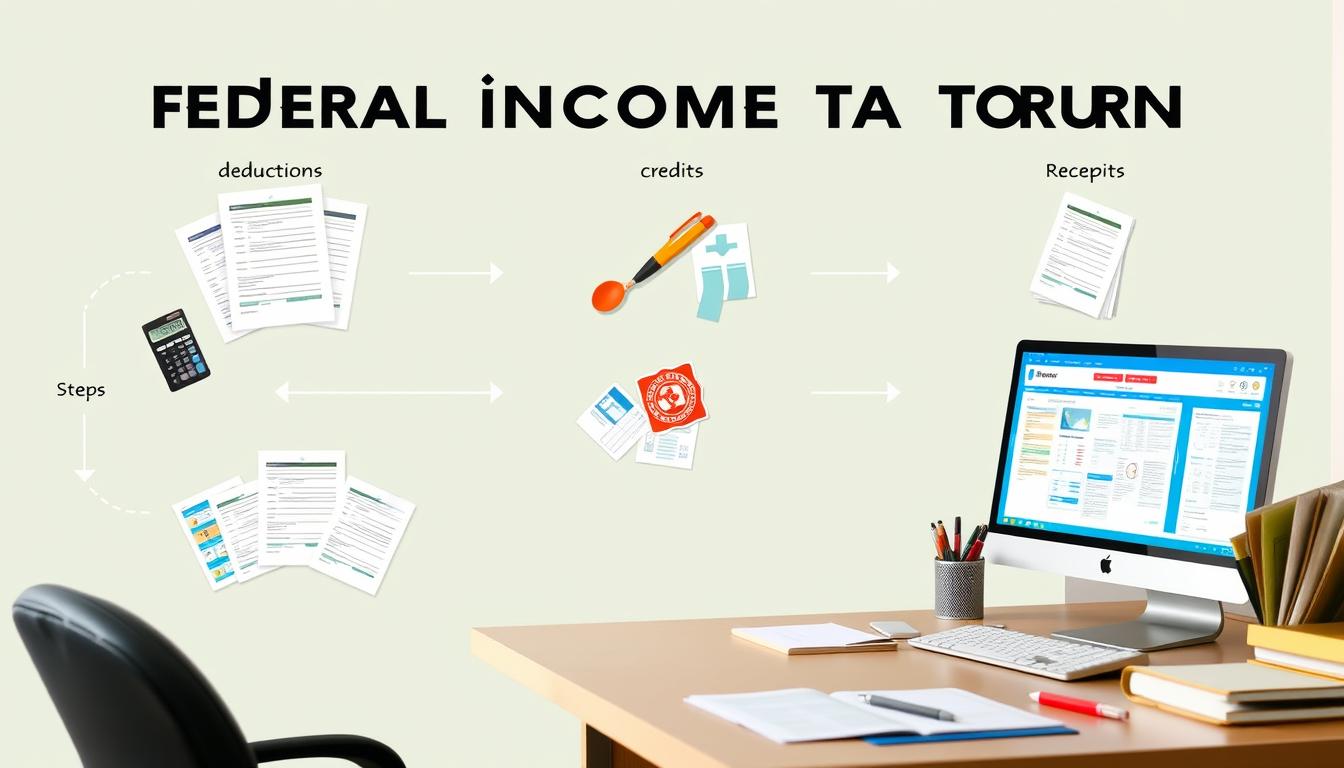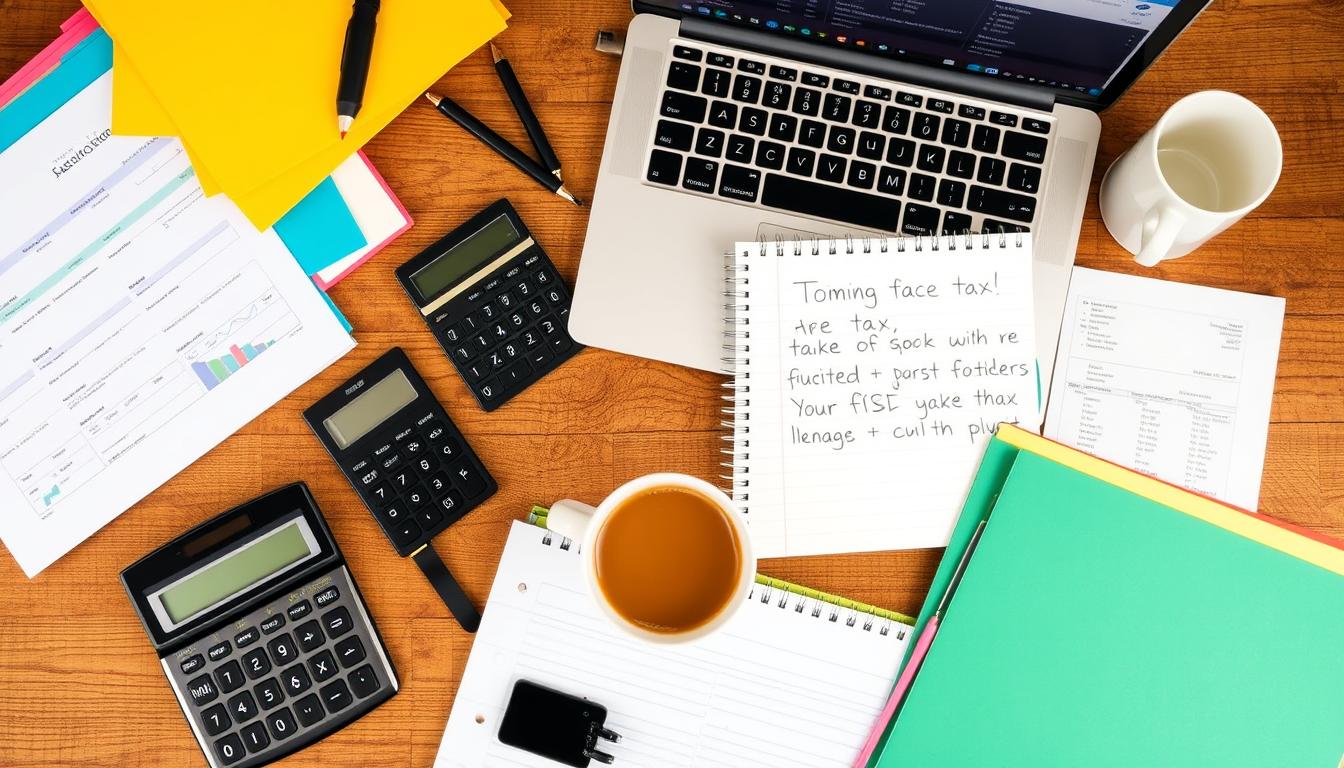Did you know more than 90% of U.S. taxpayers file their taxes online each year? This shows how many prefer the quicker, easier digital method. As April 15, 2024, draws near, getting a grip on tax filing is vital1. Our guide aims to make filing your federal taxes simple, ensuring you get any refunds due without breaking any rules.
This article gives you easy steps to follow, reducing tax season stress. It’s here for first-timers or anyone needing a quick update. With it, you’ll approach your federal taxes with more confidence.
Key Takeaways
- Filing your federal income tax return electronically can significantly speed up processing times.
- The upcoming deadline for tax returns is April 15, 2024, ensuring timely compliance.
- Understanding your filing requirements can prevent costly mistakes.
- Utilizing available tax credits and deductions can maximize your refund.
- You can file for an extension if you cannot meet the deadline.
Understanding Federal Income Tax Returns
A federal income tax return is a key document. It reports your earnings, expenses, and tax details to the IRS. Knowing the different types of tax returns is key. This helps you follow the rules and make the most of your taxes. Most of the government’s money comes from income taxes. So, it’s crucial to be accurate when you submit your tax return2. Form 1040 is widely used. It lets taxpayers report their income, figure out deductions, and claim credits.
There are different forms for everyone, depending on how you’re filing. Single people or married couples filing together might use different forms. This helps each person manage their tax duties better. Always understand the parts of your return. This includes your income, deductions, and exemptions. It helps you get the concept of tax returns explained better3.
If you work for yourself, you’ll need to cover all your own payroll taxes. This big cost affects your total federal tax bill2. For 2023, the standard deduction is $13,850 for singles and $27,700 for married couples filing together3. Knowing these numbers is helpful for filing your return.
For clarity, here’s a table. It gives you key info about federal income tax returns:
| Type of Tax Return | Eligibility | Additional Notes |
|---|---|---|
| Form 1040 | All taxpayers | Basic federal income tax form |
| Form 1040-SR | Taxpayers aged 65 and older | Designed for seniors, includes larger font |
| Form 1040-NR | Non-resident aliens | Specifically for non-residents |
| Form 1040-X | All taxpayers | Used for amending previously filed returns |
It’s important to know your options for your federal income tax return. The right info helps you handle your responsibilities with confidence.
Why You Need to File a Federal Income Tax Return
Filing your federal income tax is more than following the law. It means you can get money back if you overpaid. For example, you might get tax credits and refunds that make filing worth it. In 2022, if you’re under 65 and single, you must file if you make at least $12,950. Seniors have a higher limit of $14,7004. Heads of households have their own rules. If under 65, they file at $19,400. Those 65 or older have a threshold of $21,1504.
There are many different reasons why people need to file taxes. If your earnings are more than your group’s limit, you must file. This includes self-employed people making over $4005. Filing avoids penalties and gives you peace of mind.
Your tax return is useful for more than just the government’s rules. It helps with getting loans, federal aid, and knowing about Social Security4. It’s wise to file even if not required. This way, you won’t miss out on money like the Earned Income Tax Credit or Child Tax Credit5
How to File Your Federal Income Tax Return
Filing taxes is essential for all taxpayers. It’s important to know the tax filing steps. This ensures your return is both accurate and timely. The process starts by determining your tax filing needs.
Step-by-Step Process Overview
Here are the steps for federal tax filing:
- See if you need to file based on income and status. In 2024, the deductions are $29,200 for couples and $14,600 for singles6.
- Collect all needed documents and forms, like Form 1040 or W-2s. Different forms may be required based on what you earn and deduct.
- Look into tax credits and deductions you can get. If you make $79,000 or less, you might file for free with IRS Free File1.
- Pick how you’ll file—either e-file with software like TurboTax or on paper. TurboTax and H&R Block offer easy-to-use platforms for filing6.
- Turn in your tax return by the deadline, April 15 for the year 2023 tax returns1.
Identify Your Filing Requirements
Different things affect your need to file taxes:
- Check if your income is above the IRS filing threshold.
- Your marital status affects your taxes. You can file as single, married, or head of household.
- Special rules may apply, like for military members overseas1.
- If you’re elderly, disabled, have a low income, or need language help, free tax preparation might be available1.

Gathering Necessary Documents
Before you start filing your federal income tax return, it’s critical to gather the right documents. This ensures a smooth experience. You must understand the importance of W-2 and 1099 forms as they are key to reporting your income accurately.
W-2s and 1099s Explained
Employers provide W-2 forms that show your earnings and taxes withheld last year. They must send these by January 31, so you have them in time for filing7. 1099 forms, on the other hand, report income like freelance work or investment gains. You usually get these between January 31 and mid-February7.
Keeping these forms in order makes filing your taxes easier while ensuring you report all income sources correctly. By tracking W-2 and 1099 forms, you reduce mistakes. This can help avoid delays or issues with your tax return, possibly increasing your refund.
Other Important Documents
There are more essential documents besides W-2 and 1099 forms. For example, records of childcare expenses, mortgage details, and charity donations help claim deductions and credits. You can deduct up to $10,000 of state and local taxes without receipts7. Keeping proof of contributions to retirement accounts also helps. They can lower your taxes owed, making these records vital8.
Keeping track of your adjusted gross income (AGI) and past returns helps in accurate reporting. Storing all needed documents in one place makes filing easier. It also prepares you for audits. You should keep your financial records for seven to ten years9.
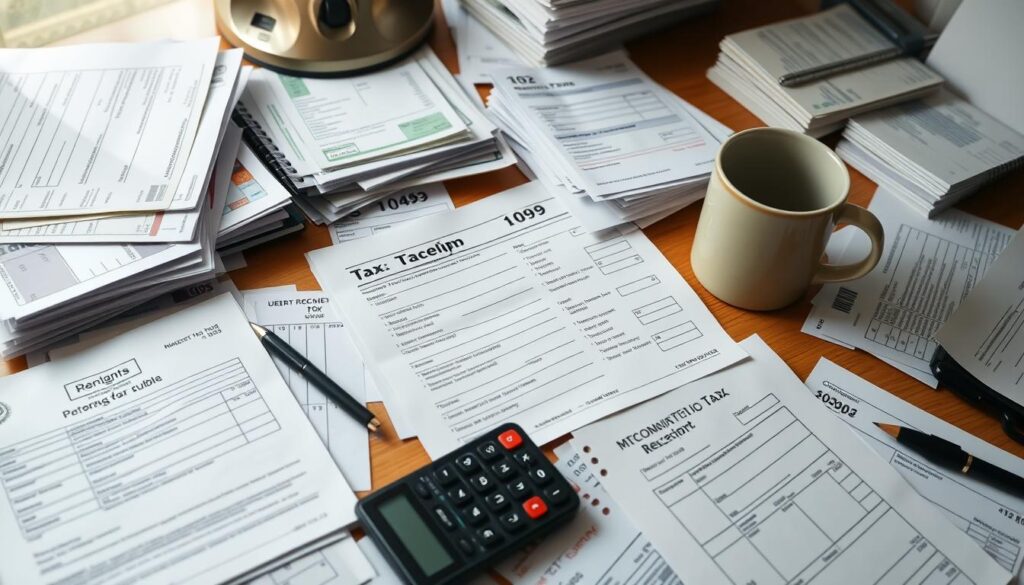
| Document Type | Purpose | Important Timing |
|---|---|---|
| W-2 Forms | Report income and withheld taxes | Must be received by January 31 |
| 1099 Forms | Detail other income like freelance work | Typically received by mid-February |
| Receipts for Deductions | Document charitable donations and other deductions | Keep for at least seven years |
| Bank Account Information | Necessary for direct deposit of refunds | Have ready when filing |
Exploring Credits and Deductions
Getting to know tax credits and deductions is key to getting the most out of your tax return. These benefits can really cut down your tax bill. It’s important to know what you might be eligible for come tax time.
Let’s look at popular tax credits and key deductions you might get.
Common Tax Credits
Taxpayers have access to many credits that can lower what they owe. Here are some important ones:
- Child Tax Credit (CTC): Offers up to $2,000 for each kid under 17, with up to $1,500 per child as a possible refund with the Additional Child Tax Credit (ACTC)10.
- Earned Income Tax Credit (EITC): Great for those with low to moderate income, starting at $600 and increasing with dependents10.
- American Opportunity Tax Credit (AOTC): Up to $2,500 for allowable college costs, for the first four years of college10.
- Savers Tax Credit (STC): Gives up to $1,000 for saving for retirement10.
- Residential Clean Energy Credit: Helps cover costs for using renewable energy in your home10.
Deductions You May Qualify For
There are many tax deductions you could claim to lower your taxable income. Some you can itemize are:
- Standard Deduction: For 2023, it’s $13,850 for single filers, $20,800 for head of household, and $27,700 for married filing jointly11.
- Student Loan Interest Deduction: Claim up to $2,500 for paid student loan interest10.
- Mortgage Interest Deduction: Deduct interest on a home loan.
- Charitable Contributions: Money given to charity can often lower your taxable income.
- Medical Expenses: Expenses more than 7.5% of your income might be deductible11.
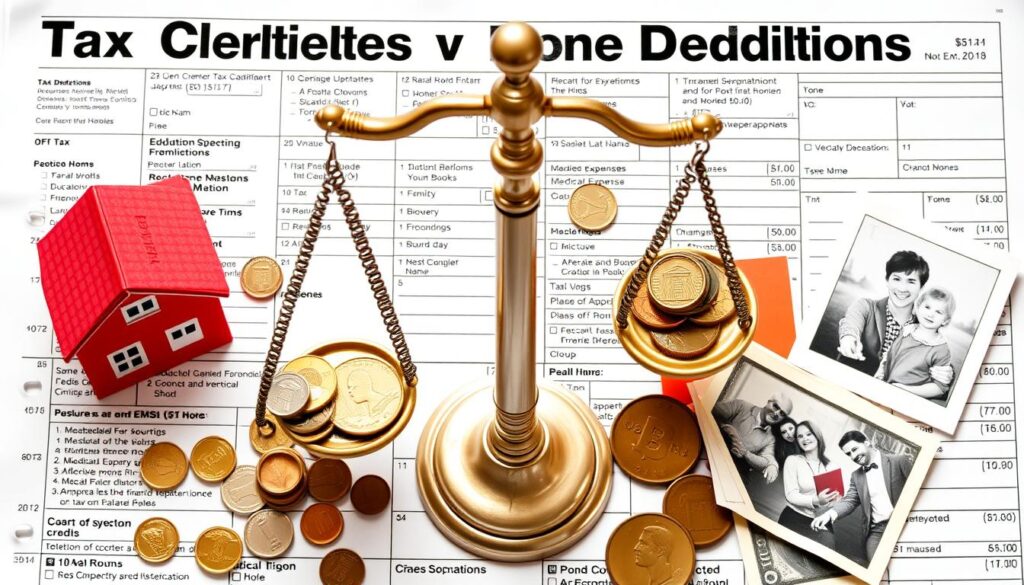
Filing Methods: E-filing vs. Paper Filing
There are two ways you can file taxes: e-filing and paper filing. Each has its pros and when it’s best to use. Knowing the differences helps you choose what’s best for you.
Advantages of E-filing
E-filing is quick and convenient for many. The IRS can process e-filed returns in 1-2 days. This is much faster than paper filing12. E-filers can get their tax refunds in about three weeks. Paper filers might wait up to six weeks12. Plus, you get instant confirmation from the IRS that they got your return13.
E-filing is also more accurate. The system does calculations, reducing mistakes12. If errors happen, fixing them is easier than with paper returns. In 2022, over 135 million people chose e-filing. This shows it’s becoming more popular13.
When to Choose Paper Filing
But, e-filing isn’t for everyone. Some worry about online security and prefer paper’s privacy12. And if you’re not comfortable with technology, you might find paper filing better.
Paper filing is a must in certain cases. Like filing for someone who has passed or when you have documents you can’t e-file13. It also feels more transparent for some, letting them review everything before sending it off.

Choosing a Filing Option
Choosing how to file your taxes is important for a smooth experience and possible savings. You have many choices, like IRS Direct File, free file providers, and tax preparation software. Each option has its benefits, helping you decide the best way to file your taxes.
IRS Direct File
IRS Direct File lets eligible taxpayers file online directly to the IRS for free. It makes filing fast and accurate. If you make $79,000 or less, this free option is available, helping many people and families1.
IRS Free File Partners
If you earn $64,000 or less, IRS Free File partners offer free tax help. These tax software providers make filing easier with step-by-step guidance. This is especially helpful if tax laws confuse you or if you find filing tough1.
Using Tax Preparation Software
Tax preparation software is popular for being easy to use. They have clear interfaces that walk you through filing your taxes correctly to avoid mistakes. Features like importing W-2s and 1099s save time and ensure your information is right. Some software may even allow you to file for free, depending on what you earn and your tax situation14.
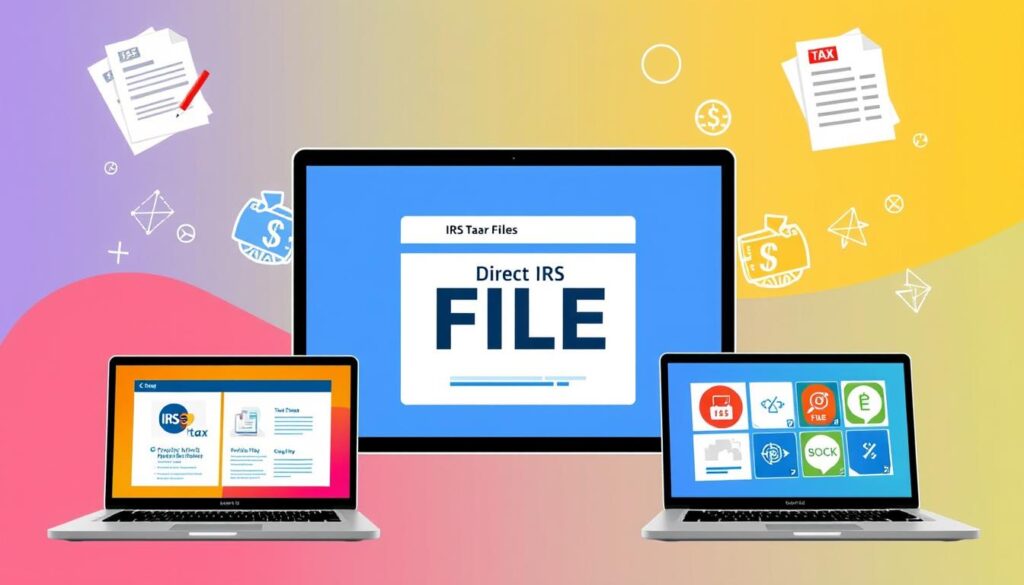
| Filing Option | Eligibility | Cost | Key Benefit |
|---|---|---|---|
| IRS Direct File | Adjusted gross income $79,000 or less | Free | Direct filing with the IRS |
| IRS Free File Partners | Adjusted gross income $64,000 or less | Free | Guided tax preparation help |
| Tax Preparation Software | Varies | Free to fee-based options | Convenient and user-friendly |
Finding the right filing option can make tax season easier and possibly boost your refund. Carefully look at your options to pick the best one for you15114.
Paying Your Taxes on Time
Paying your taxes by the due date is key to dodge penalties and interest. Keeping track of when payments are due reduces stress. It also makes sure you follow federal rules. The due date for 2025 taxes is April 15. Americans living overseas have until June 1616 to file. It’s also smart to know about quarterly estimated taxes. The last payment for these is due on January 15, 202517.
Form 4868 gives taxpayers an extra six months to file, making the new deadline October 15, 202518. Remember, this extension doesn’t mean you can pay later. To qualify for this extension, you need to have paid 90% of what you owe by April 1518.
Below is a useful table summarizing key tax payment deadlines and options:
| Payment Type | Due Date | Details |
|---|---|---|
| Federal Tax Payment | April 15, 2025 | Deadline for filing and payment. |
| Quarterly Estimated Tax Payment | January 15, 2025 | Final estimated tax payment for 2024. |
| Final Filing Deadline via Extension | October 15, 2025 | For those who filed Form 4868. |
| California State Tax Payment | April 15, 2025 | Aligns with federal tax deadline. |
Knowing these deadlines is crucial for managing your taxes well. Regular check-ups on your tax situation help make the process smoother. This way, you avoid late fees and stay in compliance with the law.
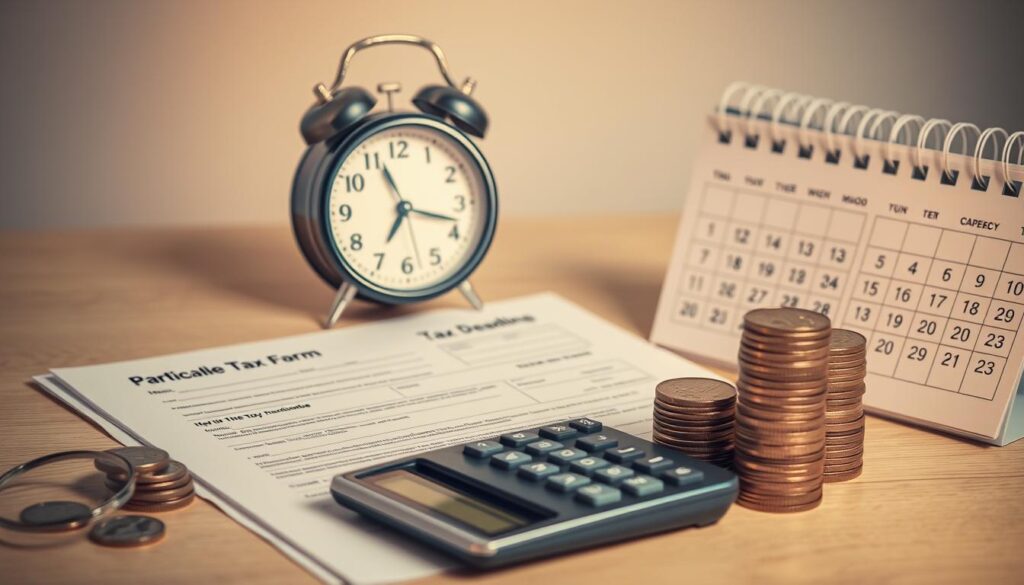
What to Do If You Cannot File by the Deadline
If you find yourself unable to meet the tax deadline, don’t worry. There are steps you can take to address the situation. We’ll show you how to ask for more time and explain what might happen if you’re late. This guide will help you stay informed and ready.
Requesting an Extension
Can’t file your taxes on time? You can ask for an extension. Just send in Form 4868 to the IRS. This gives you six more months to file. Remember, this extra time doesn’t apply to any taxes you owe. Try to pay as much as possible to lower any penalties19. If you owe money, filing quickly can also help reduce penalties and interest19.
Consequences of Missing the Deadline
Not filing your taxes can lead to problems. If you’re late, you might lose your refund or face delays in getting loans20. The IRS might file a return for you, which usually means you lose out on certain breaks20. Plus, if you owe taxes and don’t file, the IRS can start collecting, affecting your wages or bank account20.
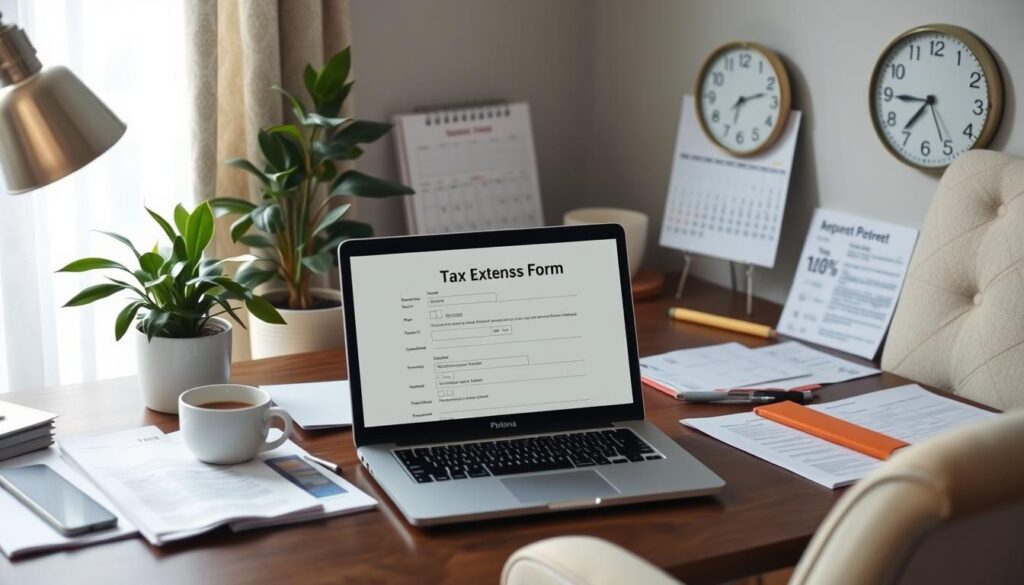
If you’ve been on time with your taxes for the last three years, you might not have to pay a penalty19. If you can’t pay due to money troubles, there are ways to get help19. It’s best to deal with tax issues early to avoid problems.
| Filing Action | Consequence |
|---|---|
| Failing to file on time | Potential loss of refund |
| Not filing | IRS may assess taxes through a Notice of Deficiency |
| Missing extension payment | Accumulation of penalties and interest |
| Repeated failure to file | Possible criminal prosecution |
Knowing your tax duties is key to a hassle-free filing1920.
How to Check Your Tax Refund Status
Once you’ve filed your taxes, it’s important to keep track of your refund. Online tools simplify this task, keeping you updated. The IRS website and mobile app let you check your refund easily. These platforms provide fast access to your tax refund status and help you understand the IRS refund process.
Online Tools for Tracking Refunds
The IRS offers several online tools to check your refund status. You’ll need your Social Security number, filing status, and refund amount. You may get a refund if you overpaid taxes or qualify for a refundable credit21. Taxpayers can claim refunds up to three years later21. If you e-filed, you could see your refund status in about 48 hours21.
Understanding Refund Processes
It’s crucial to know how long the IRS refund process takes. E-filed returns may be processed in up to 21 days21. Amended returns take longer, showing in the system in three weeks and fully processing in 16 weeks21. Refunds tied to Form 1040-NR might take six months21. For quicker refunds, consider direct deposit into a bank or retirement account21.
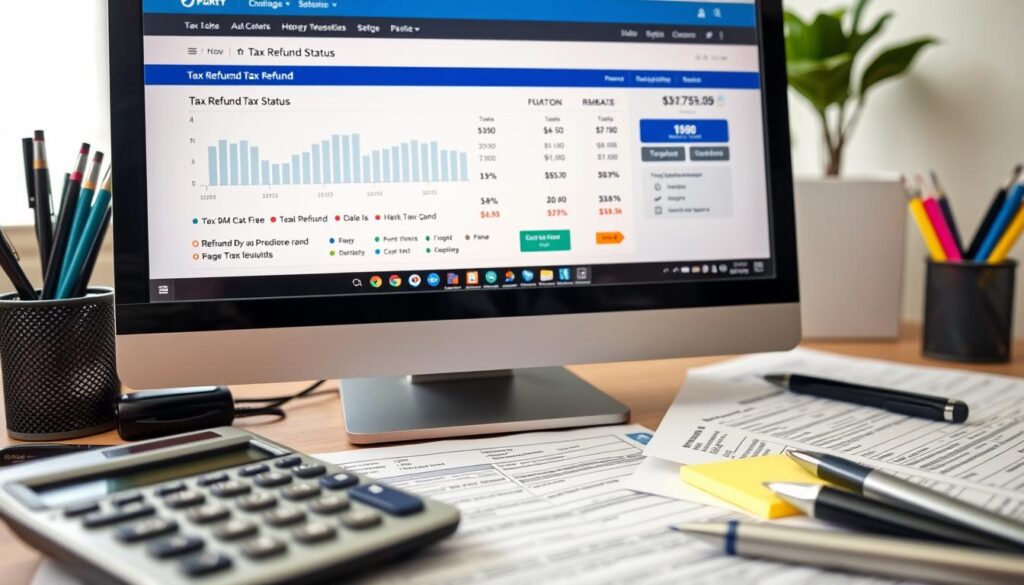
Remember, mistakes can slow down your refund. Errors on the return or incorrect account details can cause delays21. If you encounter problems, the IRS has hotlines for assistance. They provide the support needed to address any issues.
Preparing for Next Year’s Tax Season
Getting ready for tax season can help you avoid stress and make filing easier. Starting early with good tax prep tips can lead to better results. It’s important to organize your tax documents all year long. This makes the prep work easier and helps you catch all deductions and credits.
Organizing Your Documents Year-Round
Keeping your tax documents in order can stop mistakes and delays. Save all key documents like W-2 forms, 1099s, and receipts. It makes a big difference when you file. The IRS advises getting ready for the 2024 tax returns for the 2025 season by organizing everything. This avoids problems with processing and refunds that come from lost paperwork22.
- Keep an organized folder or digital space for tax documents.
- Track all income including gig jobs and unemployment, since it’s all taxable23.
- Check your records often to make sure you don’t miss anything.
Keeping Up with Tax Changes
It’s vital to stay updated on tax law changes to get the most benefits and pay the least. Knowing about changes like the reduction in bonus depreciation and business meal deductions matters for your filings24. Being aware of new rules, like needing Form 1099-K for third-party payments, gets you ready for future taxes. Tools like the IRS Online Account let you see your tax history and keep up with changes22.
- Look at IRS updates often to stay informed.
- Talking to tax professionals can give you insights on new tax laws.
- Use tax prep services that help with current regulations.
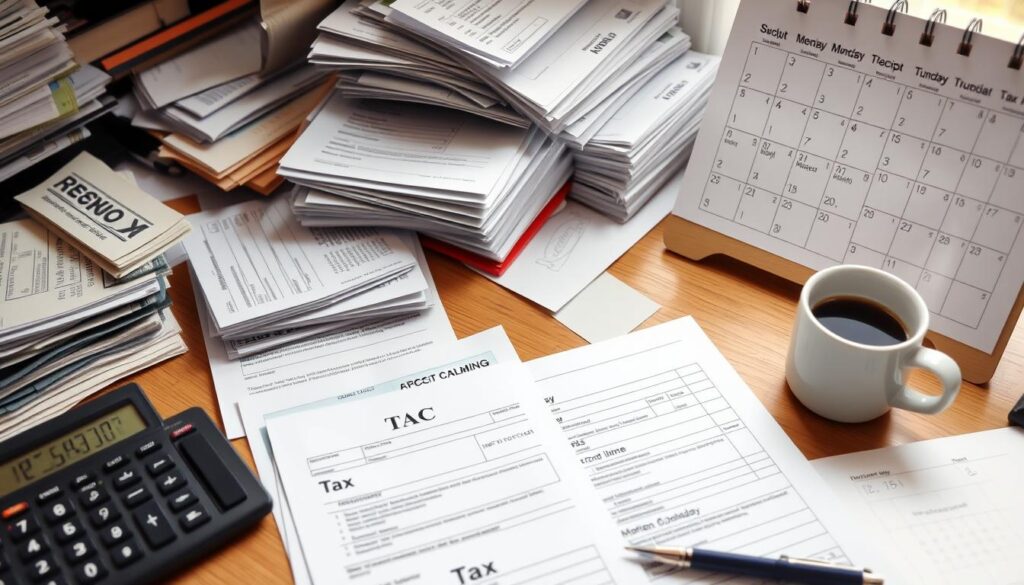
Using these tips can make moving into the next tax season smoother. It leads to more effective and correct tax filings222324.
Getting Help with Your Tax Return
Dealing with your tax return can be easier with the right help. The IRS has many IRS resources to support taxpayers. These can make the filing process clear and answer any questions you might have.
IRS Resources for Assistance
If you make $67,000 or less, the Volunteer Income Tax Assistance (VITA) program is perfect for you. It offers free tax help mostly from February to May in California. Some places even help all year25. People over 60 can use the Tax Counseling for the Elderly (TCE) program25. The GetYourRefund service is great for low-income families, with an income limit of $66,000. It helps with taxes from 2021 to 2023 and has a 4.8 rating. Clients love it because it’s easy to use and offers chat help26.
Finding Local Taxpayer Assistance Centers
For in-person help, local taxpayer assistance centers are key. They’re especially good for people with disabilities, those who don’t speak English well, and military families who get free help25. The centers offer help in English and Spanish. Be sure to bring important documents like your Social Security Card, photo ID, and proof of residency to get help easily26.

Avoiding Tax Scams and Identity Theft
As tax season draws near, watch out for tax scams. They are on the rise. It’s key to know how to spot these schemes to safeguard your money and personal info. Watch out for fake IRS agents and tax identity fraud during this period27
Being alert helps you recognize scams. Crooks might call you, pretending to be from the IRS, to demand money. Yet, the IRS reaches out via mail27. Remember, the IRS only accepts one return per Social Security number. So, filing your taxes early can help avoid fraud27. If you get a call or email without asking for it, don’t share your personal details.
Recognizing Common Tax Scams
Let’s talk about scams aiming at people. Here’s what to watch for:
- Phishing emails or texts: They may link to fake sites.
- IRS impersonation: Some might pretend to be IRS agents with false claims.
- Unsolicited calls: The IRS won’t call to demand payment.
If an unknown employer sends you a Form W-2 or 1099, get in touch with Social Security28. If someone else files a tax return with your info, the IRS will notify you by mail29. If you think there’s fraud, call 800-908-9946 right away for help28.
Protecting Your Personal Information
Keeping your info safe during tax season is vital. Here’s how to do it:
- Store your tax records and Social Security card securely.
- Destroy papers with your personal info.
- Use two-factor authentication online.
- Stay off public Wi-Fi when sending personal info.
- Make sure you’re on a secure website when filing taxes.
Being proactive boosts your security. Keeping your devices updated also helps fight online threats27. Be careful when you get urgent payment requests from people saying they’re IRS agents27.
Conclusion
As you finish this deep dive into filing taxes, remember the important steps for a successful federal tax return. The 2024 tax return deadline is April 15, 2025. But, if you have an extension, it’s October 15, 202530. Knowing the minimum income requirements for your filing status is crucial to avoid trouble31.
Good tax management means keeping up with your finances. Collect all necessary papers, look into credits and deductions, and pick the right way to file. The IRS offers help through the VITA program for those who qualify31. Start planning your taxes now, keep your records in order, and don’t hesitate to get professional advice if you need it.
This guide aims to equip you with the know-how for an easy tax season. Go into it confident, knowing what you have to do and how you can save32. With smart planning, you can handle the tax system’s challenges well.
FAQ
What is a federal income tax return?
Why do I need to file a federal income tax return?
How do I know if I need to file taxes?
What documents do I need to gather?
What are some common tax credits I can claim?
What are the advantages of e-filing over paper filing?
How can I check the status of my tax refund?
What should I do if I can’t file my taxes by the deadline?
How can I protect myself from tax scams?
Where can I find help with my tax return?
Source Links
- File your return | Internal Revenue Service – https://www.irs.gov/filing/individuals/how-to-file
- Taxes: Understanding the basics – https://files.consumerfinance.gov/f/documents/cfpb_building_block_activities_taxes-understanding-basics_handout.pdf
- Guide to filing your taxes in 2024 | Consumer Financial Protection Bureau – https://www.consumerfinance.gov/consumer-tools/guide-to-filing-your-taxes/
- Who needs to file a tax return – https://www.irs.gov/newsroom/who-needs-to-file-a-tax-return
- Check if you need to file a tax return – https://www.irs.gov/individuals/check-if-you-need-to-file-a-tax-return
- How to File Taxes: A Complete Guide – https://www.businessinsider.com/personal-finance/taxes/how-to-file-taxes
- Tax Document Checklist: What You Need to File – NerdWallet – https://www.nerdwallet.com/article/taxes/tax-prep-checklist
- Gather your documents | Internal Revenue Service – https://www.irs.gov/filing/gather-your-documents
- Documents You Should Save for Tax Time – https://turbotax.intuit.com/tax-tips/tax-planning-and-checklists/documents-you-should-save-for-tax-time/L1sk0a3uU
- Tax Deductions & Tax Credits to Know for 2024 | Equifax – https://www.equifax.com/personal/education/personal-finance/articles/-/learn/popular-tax-credits-and-deductions-2024/
- Credits and deductions for individuals – https://www.irs.gov/credits-and-deductions-for-individuals
- E-File vs. Paper File | Advantages & Disadvantages – https://www.patriotsoftware.com/blog/accounting/e-file-vs-paper-file/
- Should You E-File or File Taxes by Mail? – https://www.thebalancemoney.com/should-i-e-file-or-paper-file-3193152
- How to Change Your Tax Filing Status – https://turbotax.intuit.com/tax-tips/irs-tax-return/how-to-change-your-tax-filing-status/L5yYux3qL
- Filing Status: What It Is, How to Choose – NerdWallet – https://www.nerdwallet.com/article/taxes/how-to-choose-tax-filing-status
- Tax Day 2025: Filing Due Date and Other Deadlines – NerdWallet – https://www.nerdwallet.com/article/taxes/tax-deadline-tax-day-taxes-due
- Due dates: personal | FTB.ca.gov – https://www.ftb.ca.gov/file/when-to-file/due-dates-personal.html
- Extension of Time to File for Individuals – https://www.taxes.ca.gov/Income_Tax/extind.html
- If taxpayers missed the deadline to file a federal tax return, the IRS can help – https://www.irs.gov/newsroom/if-taxpayers-missed-the-deadline-to-file-a-federal-tax-return-the-irs-can-help
- Filing past due tax returns – https://www.irs.gov/businesses/small-businesses-self-employed/filing-past-due-tax-returns
- Refunds | Internal Revenue Service – https://www.irs.gov/refunds
- Prepare to file in 2025: Get Ready for tax season with key updates, essential tips – https://www.irs.gov/newsroom/prepare-to-file-in-2025-get-ready-for-tax-season-with-key-updates-essential-tips
- IRS ‘Get Ready’ Campaign Helps Taxpayers Prepare for Filing Season – https://www.cpapracticeadvisor.com/2024/11/24/irs-get-ready-campaign-helps-taxpayers-prepare-for-filing-season/152740/
- Tips for a better tax season – https://www.journalofaccountancy.com/issues/2024/jan/tips-for-a-better-tax-season.html
- Get free tax help | FTB.ca.gov – https://www.ftb.ca.gov/help/free-tax-help/index.html
- Free tax help from IRS-certified volunteers. | GetYourRefund – https://www.getyourrefund.org/en
- Avoiding Online Tax Scams | NCDIT – https://it.nc.gov/resources/online-safety-privacy/tips-guidance/avoiding-online-tax-scams
- Identity theft guide for individuals – https://www.irs.gov/identity-theft-fraud-scams/identity-theft-guide-for-individuals
- What To Know About Tax Identity Theft – https://consumer.ftc.gov/articles/what-know-about-tax-identity-theft
- How Much Do You Have to Make to File Taxes? – NerdWallet – https://www.nerdwallet.com/article/taxes/do-i-need-to-file-a-tax-return
- Form 1040 – Quick Guide To Fill Out Your Tax Effortlessly – https://www.xoatax.com/form-1040-guide-to-file-tax/
- IRS Provides Facts, No Conclusion, on Filing Requirement Advice – https://www.taxnotes.com/lr/resolve/tax-notes-today-global/irs-provides-facts-no-conclusion-on-filing-requirement-advice/7dyvl
